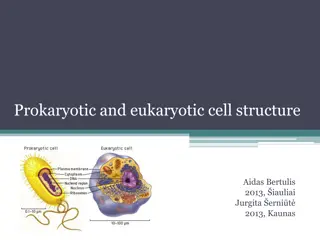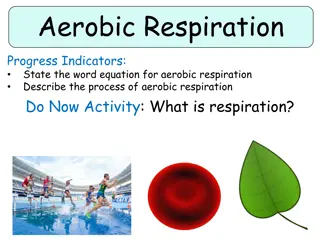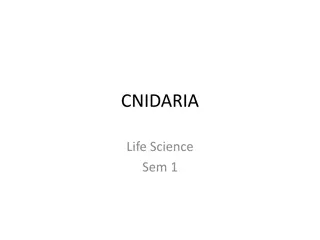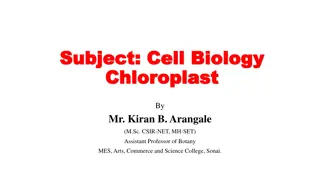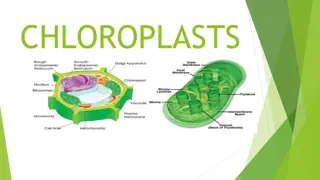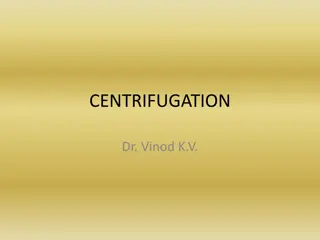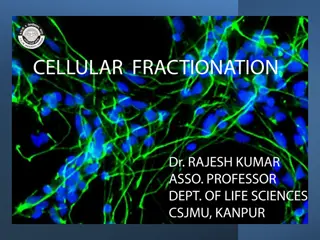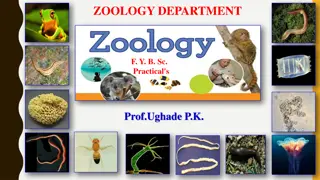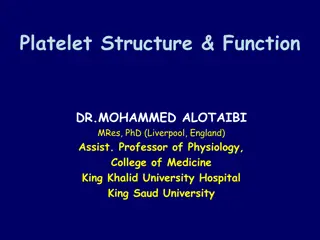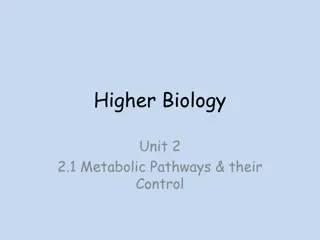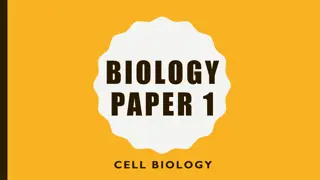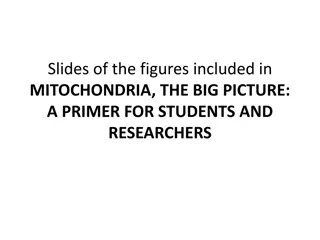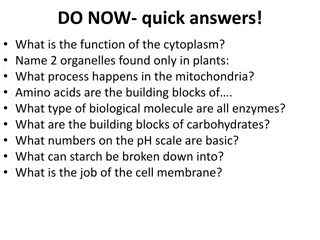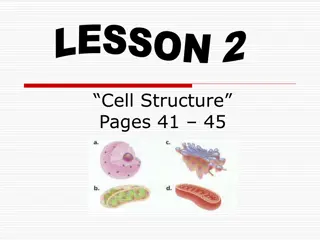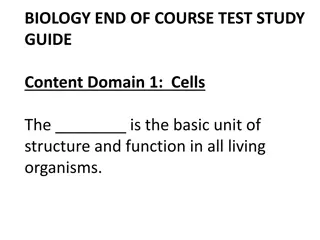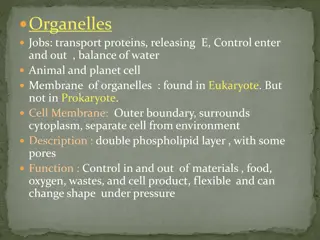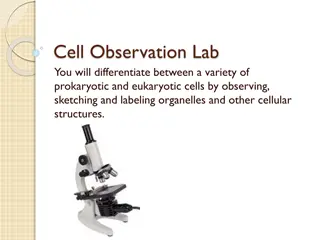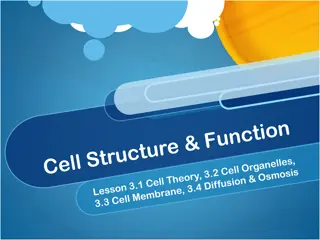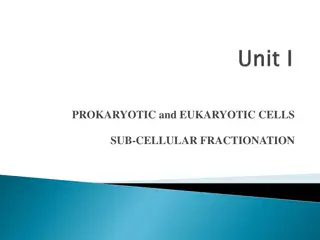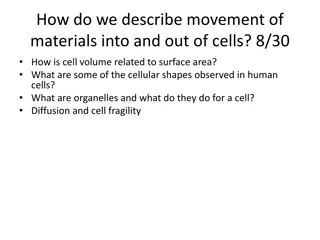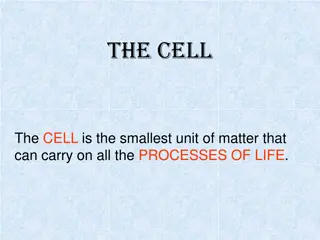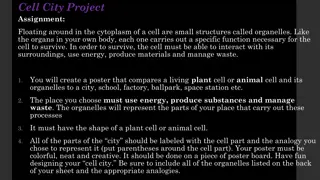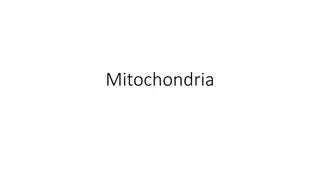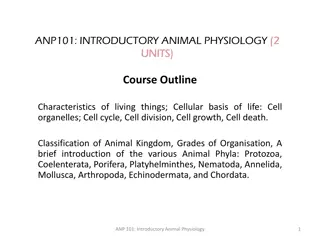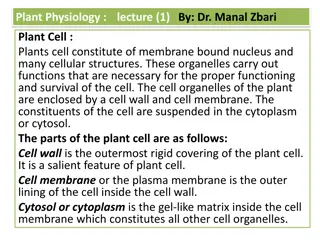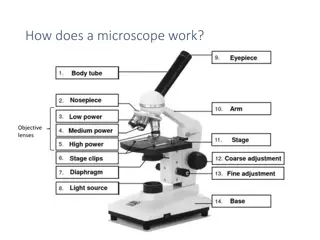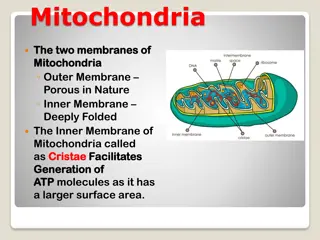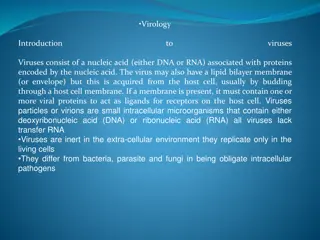Understanding Prokaryotic and Eukaryotic Cell Structure
This comprehensive guide explores the structures and characteristics of prokaryotic and eukaryotic cells. Learn about the differences and similarities between these cell types, including features like cell wall composition, membrane-bound organelles, nucleus presence, DNA structure, ribosomes, and m
7 views • 20 slides
Understanding Aerobic Respiration and Cell Structures
Explore the process of aerobic respiration, why we need oxygen for energy production, and the importance of cell structures in this metabolic pathway. Discover the role of key organelles like mitochondria and the cell membrane, as well as the differences between animal and plant cells in respiration
0 views • 10 slides
Understanding the Unique Features of Phylum Cnidaria in Life Science
Phylum Cnidaria comprises diverse marine animals like jellyfish, sea anemones, corals, and Hydra, exhibiting radially symmetric bodies with unique structures called cnidocytes. These cnidocytes serve as sensory-effector cells that contain specialized stinging organelles called cnidae, aiding in defe
0 views • 7 slides
Understanding Chloroplast: The Green Powerhouse of Plant Cells
Chloroplasts, key organelles in plant cells, contain chlorophyll for photosynthesis, producing food and oxygen. They are absent in animal cells, housing their own DNA and capable of independent reproduction. The structure includes grana and stroma, each serving vital roles in energy production withi
0 views • 11 slides
Understanding Chloroplasts: Structure, Function, and Marker Enzymes
Chloroplasts are vital organelles in plant cells responsible for photosynthesis, converting light energy into chemical energy. They contain chlorophyll pigments for light absorption and play a crucial role in synthesizing foodstuffs. Marker enzymes such as RUBISCO, NADP-Reductase, and ATP synthase a
1 views • 7 slides
Transport in the Phloem: A Detailed Overview by Ashish Sharma, Ph.D.
The phloem plays a vital role in transporting sugars and organic materials throughout plants. This system involves various specialized cells like sieve elements, companion cells, parenchyma cells, and phloem fibers. Mature sieve elements lack certain organelles and have non-lignified cell walls, mak
7 views • 32 slides
Overview of Heme Synthesis and Porphyrias
Heme is a crucial component present in various essential proteins in the body, such as hemoglobin, myoglobin, and cytochromes. The synthesis of heme takes place in multiple steps involving different organelles and enzymes in the cell. Porphyrias are a group of disorders related to heme synthesis, ch
0 views • 44 slides
Understanding the Applications and Design of Analytical Ultracentrifugation
Analytical ultracentrifugation, a powerful technique in biochemistry, allows for precise measurement of sample properties and characterization of macromolecular complexes. The method is widely used for determining sample purity, equilibrium constants, and assembly mechanisms of biological complexes.
1 views • 17 slides
Cell Structure and Function: A Comprehensive Overview
Delve into the world of cells, exploring the distinct features of animal and plant cells, the differences between prokaryotic and eukaryotic cells, the significance of organelles, and the fascinating processes such as stem cell differentiation and cell adaptation. Discover how substances move across
0 views • 5 slides
Exploring Cell Structures: An Interactive Science Lesson
Dive into the fascinating world of cells with this engaging science lesson. Discover the components of plant and animal cells, learn about organelles, and explore the differences and similarities between these fundamental building blocks of life. Through activities, visuals, and self-assessment, stu
2 views • 16 slides
Cellular Fractionation: Techniques and Applications
Cellular fractionation is a crucial process for separating cellular components to study intracellular structures and proteins. It involves homogenization, centrifugation, and purification steps to isolate organelles based on their properties like density and shape. This method provides valuable insi
6 views • 11 slides
Classification and Characteristics of Phylum Protozoa
Phylum Protozoa comprises unicellular, microscopic, eukaryotic organisms found mostly in aquatic habitats. They exhibit diverse locomotory structures such as cilia, flagella, or pseudopodia. These protists may possess a cellulose cell wall and various membrane-bound organelles like mitochondria and
0 views • 21 slides
Introduction to Histology and Cell Structure
Histology is the microscopic study of normal tissues utilizing light and electron microscopes. This field explores the composition and function of cells, focusing on the nucleus, cytoplasm, organelles, and inclusions. Thin tissue sections stained with Haematoxylin and Eosin reveal distinct cellular
0 views • 23 slides
Understanding Histology and Cell Structure Fundamentals
Delve into the intriguing world of histology and cell structure, exploring the composition of cells, the functions of various components like the nucleus and cytoplasm, and the significance of organelles. Discover how histology is studied, the types of microscopes used, and the vital role of the cel
0 views • 24 slides
Exploring Cellular Structures in Quizbowl Biology
Biology in quizbowl competitions often focuses on understanding cellular structures, from organs to organelles. Players encounter questions about various organelles like mitochondria, ribosomes, chloroplasts, and the Golgi body. Ribosomes, though not classified as organelles, play a critical role in
0 views • 27 slides
Understanding Platelet Structure and Function in Physiology
Platelets play a crucial role in hemostasis and bleeding disorders. This lecture by Dr. Mohammed Alotaibi covers the ultrastructure of platelets, functions of organelles and surface receptors, mechanisms of platelet functions, and the relationship of membrane receptors and granule content in normal
0 views • 47 slides
Understanding the Structure and Function of Cell Membranes in Biology
Explore the intricate details of cell membranes, focusing on the phospholipid bilayer structure, protein interactions, selective permeability, and various transport mechanisms. Discover how membranes regulate the entry and exit of substances, aid in metabolism, and compartmentalize organelles for ef
0 views • 20 slides
Cell Biology Overview and Organ Systems in Biology Paper 1
The Biology Paper 1 content covers topics such as cell specializations, cell division, organelles, enzyme functions, and organ systems including the cardiovascular system. It discusses key concepts like stem cells, mitosis, diffusion, osmosis, active transport, and various cell components such as nu
0 views • 8 slides
Comparison of Eukaryotic and Prokaryotic Cells in Cell Biology
Cells are the fundamental units of life, but viruses are an exception as they lack cells. Eukaryotic cells have a defined nucleus with a nuclear membrane housing chromosomes, while prokaryotic cells lack a membrane-bound nucleus and other organelles. Eukaryotic cells are larger, containing membrane-
0 views • 9 slides
Exploring Mitochondria: A Visual Overview for Researchers
Dive into the world of mitochondria with a collection of detailed figures, showcasing thin section views, fluorescent protein labeling, schematic representations of mitochondrial compartments, and involvement in processes like apoptosis and biogenesis. Discover the intricate structures and functions
0 views • 12 slides
Cellular Processes and Functions Explained
The cytoplasm is essential for cell function, housing organelles like chloroplasts and vacuoles unique to plants. Mitochondria facilitate cellular respiration, while amino acids form proteins. Enzymes are proteins, and carbohydrates consist of simple sugars. Basic pH numbers range from 8 to 14. Star
0 views • 24 slides
Understanding Cell Structure: Key Organelles and Functions
Explore the intricate world of cell structure as we delve into the functions of essential organelles such as chloroplasts, mitochondria, ribosomes, endoplasmic reticulum, Golgi bodies, vacuoles, lysosomes, and the nucleus. Uncover the significance of each organelle in maintaining the cell's processe
0 views • 13 slides
Understanding Cells: The Basic Units of Life
Exploring the fundamental importance of cells in living organisms, this study guide delves into the structure and function of eukaryotic and prokaryotic cells. It highlights the distinction between these cell types, their respective characteristics, and the defining features of living things. Emphas
0 views • 93 slides
Understanding Cell Organelles and Their Functions
Cell organelles play vital roles in the functioning of both animal and plant cells. From the cell membrane that controls the exchange of materials to the nucleus that governs cell activities, each organelle contributes uniquely. The cytoplasm provides a supportive environment for organelles, while t
0 views • 6 slides
Exploring Cell Structure and Function in Developmental Biology
Discover the intricate world of cell structure and function in the context of developmental biology. Delve into the inner workings of organelles, their functions, and how they contribute to cellular activities. Engage in interactive activities like building cell models and playing Cell Detective to
0 views • 14 slides
Cell Observation Lab for Prokaryotic and Eukaryotic Cells
Explore the differences between prokaryotic and eukaryotic cells through a hands-on lab. Observe, sketch, and label organelles in bacteria (yogurt), protists (pond water), fungi (yeast), and plant cells (onion and anacharis). Learn to differentiate cellular structures and understand the characterist
0 views • 17 slides
Understanding Cells: Structure, Function, and Evolution
Explore the world of cells, the basic units of life, from their structure and function to the history of cell theory. Learn about prokaryotic and eukaryotic cells, the cytoskeleton, and key organelles. Dive into differences between animal and plant cells and the critical role of chloroplasts in ener
0 views • 28 slides
Prokaryotic and Eukaryotic Cells: A Comparative Overview
Prokaryotic cells are simpler and lack membrane-bound organelles, reproducing through binary fission. Eukaryotic cells are more complex, larger, with a nucleus enclosed in a nuclear envelope. They have various organelles and a cell wall. The plasma membrane defines cell boundaries, regulating the pa
0 views • 13 slides
Understanding Cellular Transport and Concentration in Biology
Explore the movement of materials into and out of cells, the relationship between cell volume and surface area, various cellular shapes observed in human cells, the functions of organelles, diffusion, cell fragility, units of concentration measurement, regulation of movement across plasma membranes,
0 views • 20 slides
Exploring the Fascinating World of Cells and Organelles
Delve into the intriguing realm of cells and organelles, the building blocks of life. Discover the origins of the cell theory, the contributions of pioneers like Anton von Leeuwenhoek and Robert Hooke, and the essential functions of key organelles like the cell membrane, nucleus, mitochondria, and m
0 views • 31 slides
Cell City Project: Explore the Intriguing World of Cell Organelles through Creative Analogy
Dive into the fascinating realm of cell organelles through the engaging Cell City Project assignment, where students illustrate and compare them to various urban structures. Learn about the functions of organelles by likening them to elements of a city, emphasizing energy usage, material production,
0 views • 8 slides
Understanding Cell Structure and Function
Explore the intricate world of cell biology through this comprehensive guide covering the definition of a cell, the characteristics of animal cells, the role of the nucleus, ribosomes, cell structure, organelles, cell membrane, and cell wall. Discover the fascinating details of eukaryotic cells and
0 views • 61 slides
Understanding the Functions of Cell Organelles
Explore the vital functions of different cell organelles such as the cell membrane, nucleus, endoplasmic reticulum, lysosomes, Golgi apparatus, mitochondria, cytoplasm, ribosomes, vacuole, cell wall, chloroplasts, and chlorophyll in a cell. Learn how each organelle plays a unique role in maintaining
0 views • 38 slides
Understanding the Structure and Function of Mitochondria
Mitochondria, derived from Greek words meaning thread and granule, are essential organelles found in eukaryotic cells. They serve as energy powerhouses, metabolizing carbohydrates and fatty acids to produce adenosine triphosphate (ATP). The inner and outer membranes of mitochondria contain proteins
0 views • 14 slides
Introduction to Animal Physiology and Cellular Biology Overview
This comprehensive course delves into the fundamental aspects of animal physiology and cellular biology. Topics covered include the characteristics of living organisms, cellular organelles, the cell cycle, division, growth, and death. Additionally, the course introduces the various animal phyla, fro
0 views • 43 slides
Understanding Plant Cell Physiology and Functions
Plant cells are the fundamental units of life in the Plantae kingdom, comprising various organelles like the nucleus, chloroplasts, and mitochondria. These cells perform essential functions such as photosynthesis, cellular respiration, and storage. Differentiated by their unique cell walls, chloropl
1 views • 24 slides
Exploring the World of Microscopes and Cells
Delve into the fascinating world of microscopes and cells with details on how microscopes work, the functions of key microscope parts, the structure and function of cells, levels of organization in living organisms, and the concept of specialized cells. Discover the importance of objective lenses, f
0 views • 26 slides
Understanding Mitochondria, Plastids, and Chloroplasts in Cells
Mitochondria, known as the powerhouse of the cell, generate ATP for energy production through cellular respiration. Plastids, such as leucoplasts, store various compounds like starch and proteins. Chloroplasts conduct photosynthesis in plants, utilizing chlorophyll and performing light-dependent rea
0 views • 10 slides
Understanding Viruses: A Brief Overview of Virology
Viruses are small intracellular microorganisms consisting of nucleic acid and proteins, often enclosed in a lipid bilayer membrane acquired from host cells. They lack cellular structure and organelles and rely on host cells for replication. Control measures for viruses include leveraging knowledge o
0 views • 20 slides
Exploring Animal Cell Organelles and Functions
Dive into the intricate world of animal cell organelles and their functions. From the plasma membrane to the nucleus, ribosomes, endoplasmic reticulum, Golgi apparatus, mitochondria, and more, uncover the essential components that drive cellular processes. Discover the roles these organelles play in
0 views • 7 slides
